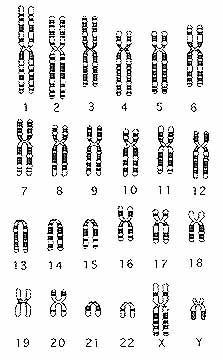

In terms of understanding human evolution, paleoanthropologists now have an additional tool (in addition to the fossil record), provided by geneticists. This is the direct study of DNA, and DNA comparison between living organisms, and sometimes between ancient fossils and living organisms.
DNA, or deoxyribonucleic acid, is found in the nucleus of body cells, on the chromosomes. Segments of DNA that code for specific proteins are called genes, and humans have some 25,000 genes carried on our 23 pairs of chromosomes. Most actual physical traits are influenced by more than one gene on more than one chromosome; only a few traits, such as ABO blood system and certain diseases, are determined by one specific gene on only one pair of chromosomes. As noted, of your 23 pairs of chromosomes, one of each pair is from your mother, the other of that pair from your father. Chromosomes vary in length, and in the amount of DNA that they carry. A common way to depict the 23 pairs of chromosomes is by length, with the longest pair of chromosomes given the number 1. This depiction is called a karyotype.

Human Karyotype
The first 22 pairs of chromosomes look essentially the same for all humans, as depicted above. The 23rd pair are called the sex chromosomes because they are different between males and females. Males have one large 23rd chromosome, called the X chromosome, and one very small chromosome, the Y chromosome, as shown above. Females have two of the large X chromosomes. In the process of cell division forming the sex cells, a pair of chromosomes (say the 1st pair) exchanges genetic material, so that though the sex cell you produce has only one of each pair, that one includes a mixture of DNA that you yourself got from both your father and your mother. The X chromosomes will do the same exchange during cell division. The Y chromosome, paired in males with an X chromosome, can not exchange genetic material with the X chromosome during cell division. Hence for males, their Y chromosome is inherited from their father, and is identical in DNA to the one he inherited from his father, etc. Except for the occasional mutation, if you are a male your Y chromosome is identical genetically to that of your father, your father's father, and your great great great great great great grandfather tracing that ancestry only through males. This fact allows for males to trace ancestry, and relationships back thousands of years. We will get to the paleoanthropological usefulness of this fact a bit later.
Even more useful for paleoanthropologists is mitochondrial DNA. Mitochondria are organelles within animal cells which provide the cell with energy. Mitochondria contain DNA, called mitochondrial DNA or mtDNA. Mitochondria are present in the human egg and in the human sperm. The mitochondria of a sperm are found in the tail; when the sperm fertilizes the egg the tail breaks off and does not enter the egg. Therefore the fetus, whether male or female, gets all its mtDNA from its mother. A female's mtDNA is therefore identical to her mother's, her mother's mother, her mother's mother's mother, etc., except for mutations. Like the Y chromosome, mtDNA studies can be used to trace ancestry and relationships back for thousands of years.

Mitochondria DNA(dividing)
MtDNA, like regular DNA, does mutate from time to time in the process of cell division. Many mutations are neutral, and if this happens in mtDNA the mutation will simply be passed on to all descendants in the female line. If two modern females share a common female ancestor in the past, that can be established by looking at the mtDNA. If the mutation rate is known for mtDNA (and it is), comparing the number of mutations between any two living women can come up with an estimate of how long it has been since these two women did have a common ancestor. If indeed humans and apes share a common ancestor in the past, comparisons of the mtDNA of living humans with that of living apes should give an idea of exactly how long it has been since that common ancestor.
When such comparisons were first published in the late 1970's and early 1980's, the conclusion as to our closest relatives was the same as that indicated by other types of evidence: the African apes (chimpanzees and bonobos, and to a lesser extent, gorillas). The conclusion as to how long we had been separated from them, 5-6 million years, did not at the time fit with the very limited fossil evidence, and it was widely discounted by paleoanthropologists. Now, some 30 years later, the mtDNA evidence still says that chimpanzees, bonobos, and humans had a common ancestor some 5-6 million years ago, and the more extensive (though still limited) fossil evidence agrees with this date. As we shall see, mtDNA evidence has had considerably more to contribute to our understanding of human evolution and of population movements.